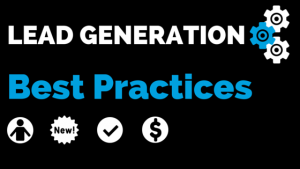Every business – from a multinational corporation to a local bakery — must attract new customers in order to thrive. Any company that fails to reach new markets and capture new revenue is at risk of losing to the competition. This has been the challenge of businesses and marketing professionals for generations.
Modern Approaches
But modern day marketing initiatives and lead-generation campaigns are changing fast. With the rise of new online and social media techniques old-school approaches are no longer appropriate or effective. Studies show that the average consumer is hit with over 5,000 marketing messages every day. As a result, marketers need to find new ways to generate leads, reach new buyers and get heard through the noise. Here are four best practices to consider as you map your strategy.
Best Practice #1 – Know Your Target Audience
It can be difficult to craft the right message if you don’t know much about your audience. Start with demographic data, but look at psychographic information as well – what are the values, opinions, attitudes, and interests of your best customers? From there you can understand the offers and message platforms that will resonate with these prospects deliver greater return on your lead generation efforts.
Best Practice #2 – Killer Content Marketing Strategy
Content marketing is the hottest trend in marketing today and if you are not paying attention you can bet that your competition is. Relevant content is important because the internet, social and mobile technology has changed how most customers buy – they don’t call the company, they go online and research for themselves. Marketers must fill the gap with customers by providing educational and pointed content with engaging calls-to-action that are designed to influence the early stages of their buying process.
Best Practice #3 – Plan, Do, Check, Act
The venerable TQM guru, W. Edwards Deming, made the axiom Plan, Do, Check, Act a classic tenet of process improvement. Even the most well-planned lead generation campaign can miss the mark the first time around. So it is important to plan your campaign, test it, adjust as needed, and test again in order to be effective long-term. One way to do that is to select a small sample size (less than 10%) and run a portion of a campaign to that sample. Evaluate the results to learn what elements worked and what aspects need improvement, through iterative approach you will be able to increase your conversion rates. From there, roll out the tested and tweaked campaign to the rest of the audience.
Best Practice #4 – Automate Your Lead Generation Efforts
CMOs are rethinking old-school lead generation tactics and adopting a more automated approach. Studies show that spending on marketing automation software is on the rise as a result. It is now possible, through marketing automation, to design multistep lead generation campaigns that track and respond to customer behaviors. Campaign managers can create, collaborate, target and deliver multi-channel lead-oriented processes through landing pages, email marketing, social marketing, banners and traditional print channels.
Moving Forward
By knowing your audience and testing your campaigns before you launch you reduce your risk of making sub-optimal investments in lead generation. By streamlining the process with marketing automation you can a leg up in market penetration. And by doing so, you will not only gain greater brand recognition with your prospects, you will be more effective at moving them forward through the buying process. The result will be significantly improved campaign performance that will differentiate you from your competitors.